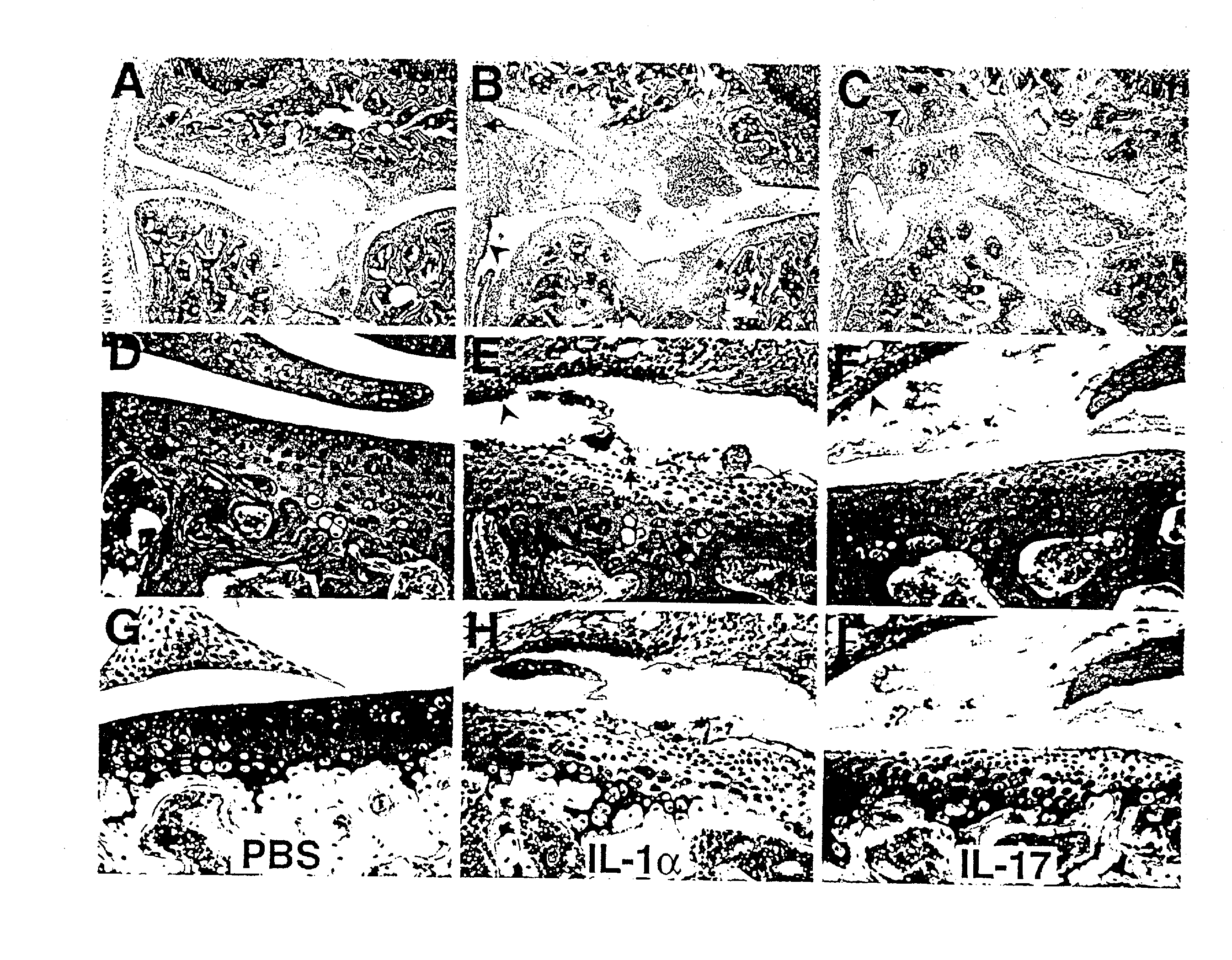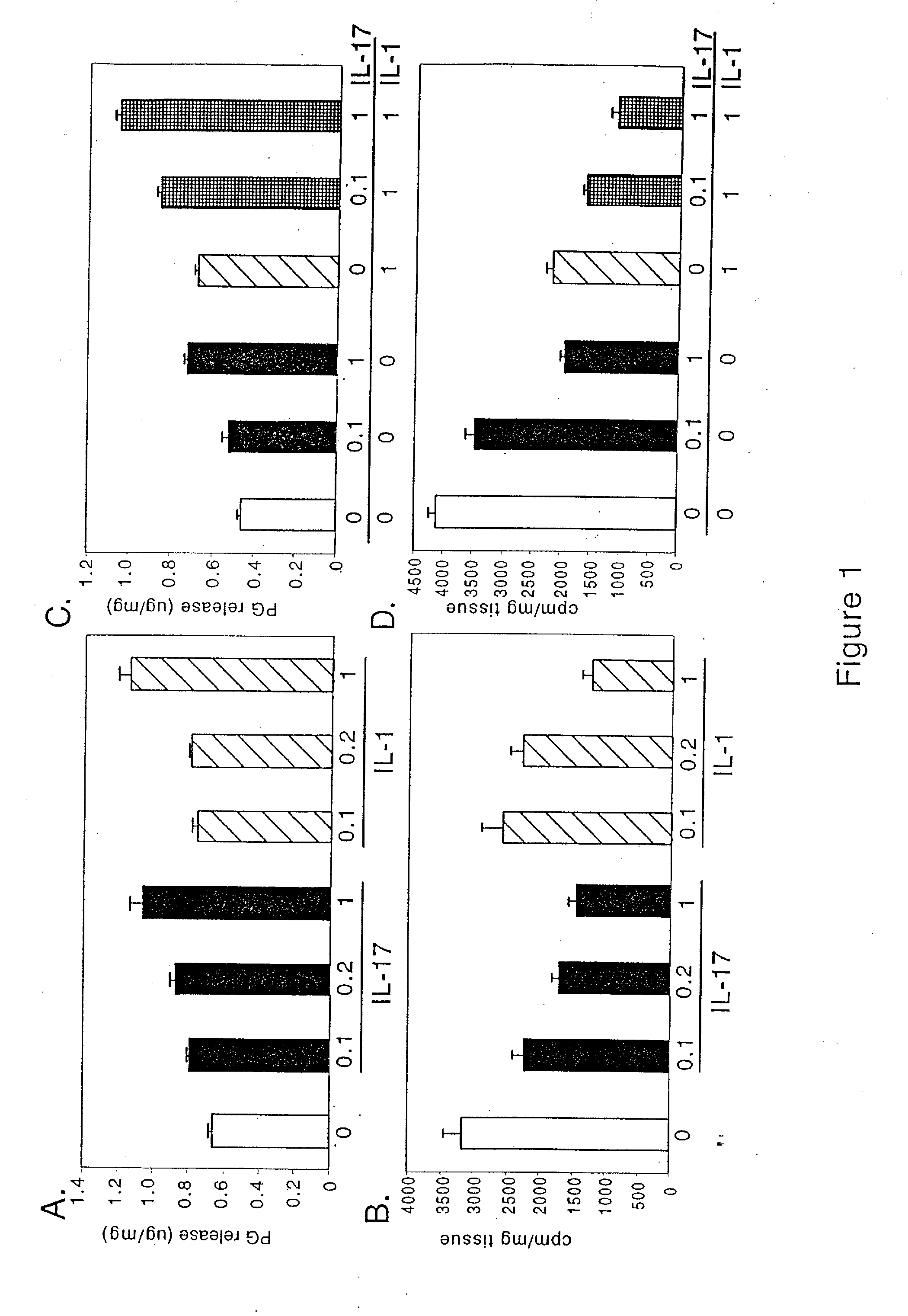Use of il-17 antibody for the treatment of cartilage damaged by osteoarthritis
a cartilage damage and antibody technology, applied in the direction of antibody medical ingredients, peptide/protein ingredients, peptide sources, etc., can solve the problems of tissue transplants from donors at risk of graft rejection, infection transmission, and further surgery, so as to stimulate the repair and prevent the degradation of cartilage
- Summary
- Abstract
- Description
- Claims
- Application Information
AI Technical Summary
Benefits of technology
Problems solved by technology
Method used
Image
Examples
example 1
Effect of Interleukin-17 on Cartilage Matrix Turnover
[0314] The experiments of this example examine the effect of IL-17 on cartilage matrix turnover. This effect is determined by measuring matrix (i.e. proteoglycan) synthesis and breakdown, as well as nitric oxide production, in articular cartilage. These parameters are evaluated in the presence and absence of interleukin 1α, IL-1α. Articular cartilage explants have several advantages over primary cells in culture. First, and perhaps most importantly, cells in explants remain embedded in tissue architecture produced in vivo. Secondly, these explants are phenotypically stable for several weeks ex vivo, during which time they are able to maintain tissue homeostasis. Finally, unlike primary cells, explants can be used to measure matrix breakdown. To set up cartilage explants, articular cartilage must be dissected and minced which results in disruption of the collagen network and release of proteoglycans into the culture media. This sy...
example 1a
Effect of IL-17 Upon Cartilage Matrix Metabolism
[0316] To determine whether IL-17 affects cartilage matrix metabolism, porcine articular cartilage explants were treated with a range of IL-17 concentrations, and proteoglycan synthesis and breakdown were measured. At concentrations as low as 0.1 ng / ml, IL-17 induced significant cartilage breakdown (FIG. 1A) and inhibited new matrix synthesis (FIG. 1B), with comparable potency to IL-1α. When IL-1α (1 ng / ml) and IL-17 (0.1 or 1 ng / ml) were combined, an enhancing, apparently additive, effect was observed on both matrix breakdown (FIG. 1C) and synthesis (FIG. 1D). Unlike what was found in a prior study (Chabaud et al., Arthritis Rheum. 42(5): 963-970 (1999), no synergism between IL-1α and IL-17 was observed.
[0317] To test for species-related effects, the ability of IL-17 to alter matrix metabolism in bovine articular cartilage explants was measured. While both IL-17 and IL-1α increased proteoglycan breakdown and inhibited matrix breakdo...
example 1b
IL-17 Induction of Catabolic Proteins
[0319] To determine the role of IL-1 in IL-17-induced matrix turnover, explants were treated with IL-17 plus IL-1α antagonist (IL-1ra). Although IL-1ra inhibited the effects of IL-1α on articular cartilage explants, IL-1ra neither blocked IL-17-induced matrix breakdown (FIG. 2A) nor prevented inhibition of matrix synthesis by IL-17 (FIG. 2B). Thus, the effects of IL-17 on matrix turnover were not dependent on IL-1 production by chondrocytes.
[0320] To determine the role of LIF in IL-17 activity, articular cartilage explants were treated with antibodies to LIF (anti-LIF) alone, or in combination with IL-17 or IL-1α inhibition of LIF significantly decreased IL-17 and IL-1α induced matrix breakdown (FIG. 2A), and partially overcame the inhibitory effects of IL-17 and IL-1α on matrix synthesis (FIG. 2B). The effect of anti-LIF on basal matrix turnover suggests that porcine explants synthesize active LIF under serum-free conditions (FIG. 2). Furtherm...
PUM
| Property | Measurement | Unit |
|---|---|---|
| concentrations | aaaaa | aaaaa |
| concentrations | aaaaa | aaaaa |
| concentrations | aaaaa | aaaaa |
Abstract
Description
Claims
Application Information
 Login to View More
Login to View More - R&D
- Intellectual Property
- Life Sciences
- Materials
- Tech Scout
- Unparalleled Data Quality
- Higher Quality Content
- 60% Fewer Hallucinations
Browse by: Latest US Patents, China's latest patents, Technical Efficacy Thesaurus, Application Domain, Technology Topic, Popular Technical Reports.
© 2025 PatSnap. All rights reserved.Legal|Privacy policy|Modern Slavery Act Transparency Statement|Sitemap|About US| Contact US: help@patsnap.com



